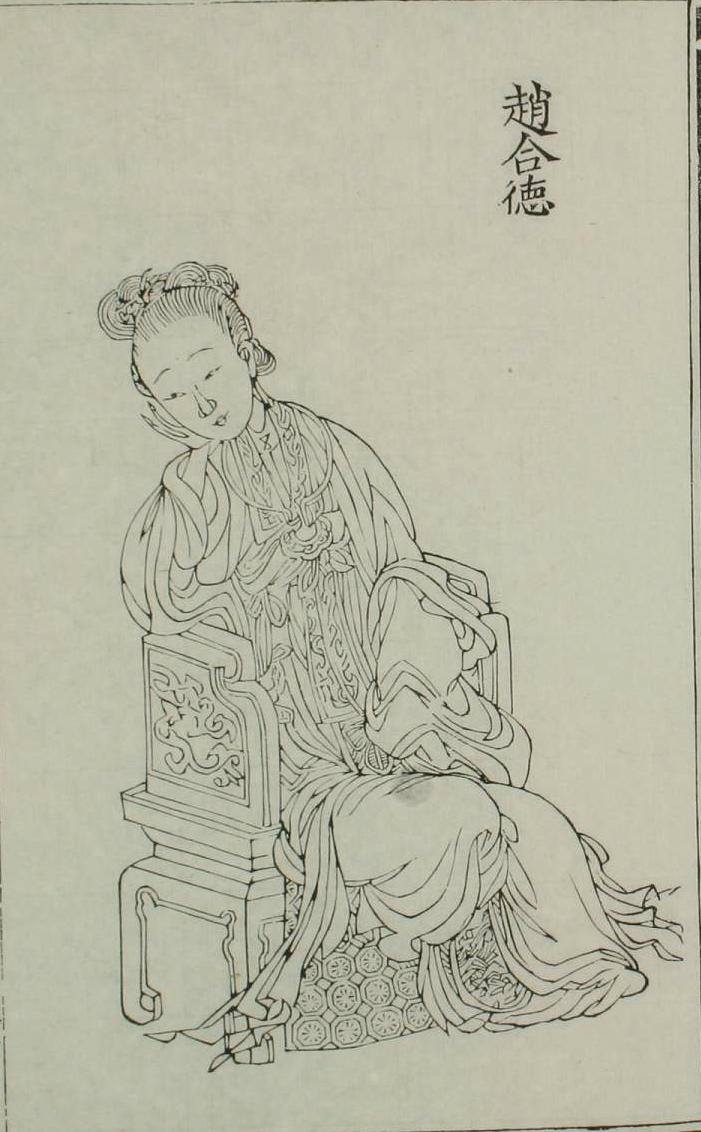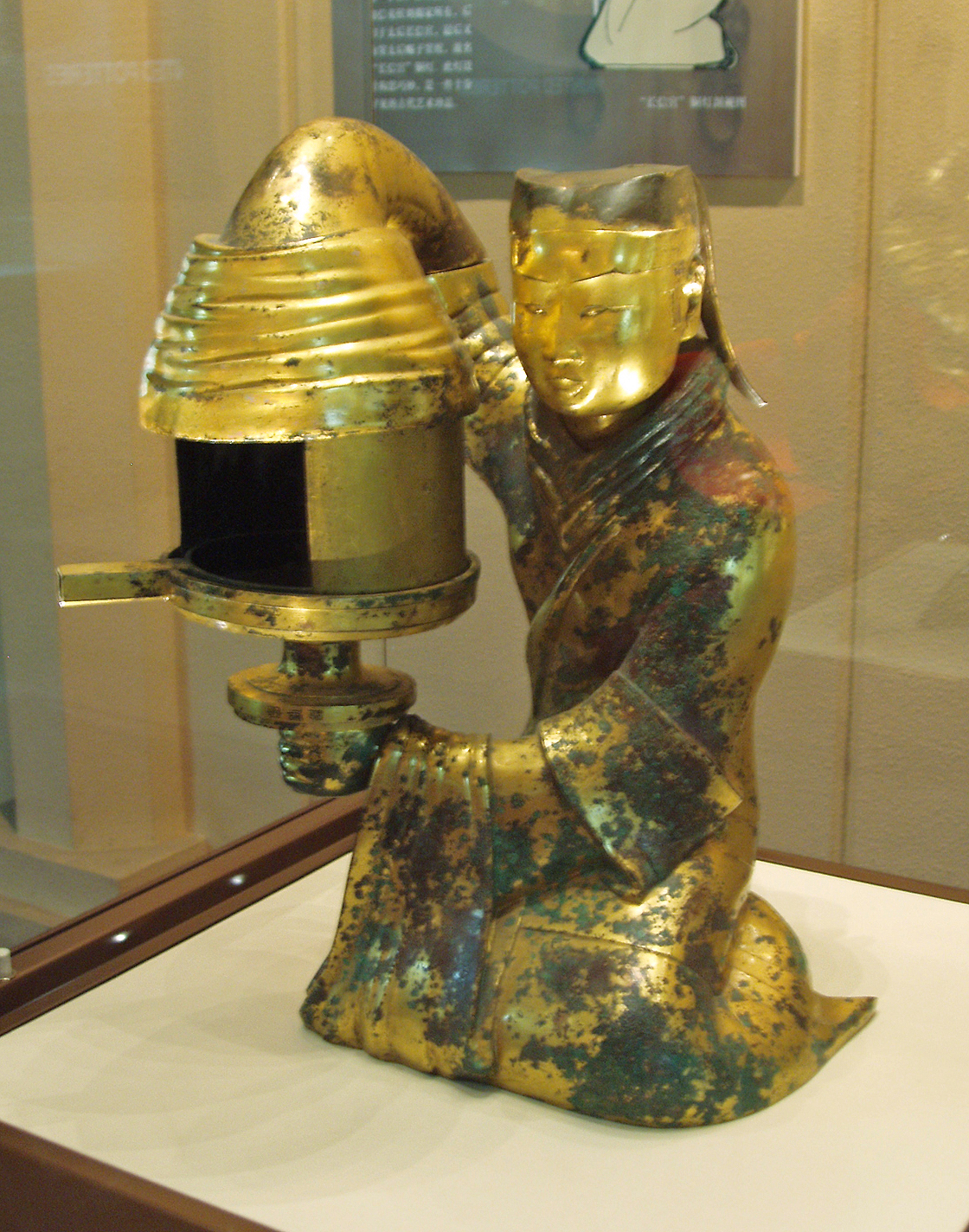|
Emperor Ai Of Han
Emperor Ai of Han (27 BCE – 15 August 1 BCE) was an emperor of the Chinese Han dynasty. He ascended the throne when he was 20, having been made heir by his childless uncle Emperor Cheng, and he reigned from 7 to 1 BCE. The people and the officials were initially excited about his ascension, as he was viewed by them (as well as Emperor Cheng) to be intelligent, articulate, and capable. However, under Emperor Ai, corruption became even more prevalent and heavy taxes were levied on the people. Furthermore, Emperor Ai was highly controlled by his grandmother Consort Fu (consort of his grandfather and his predecessor's father Emperor Yuan), who demanded the title of Grand Empress Dowager—even though she had never been an empress previously and therefore did not properly hold that title, and this led to the unprecedented and unrepeated situation of four women possessing empress dowager titles at the same time—Empress Wang (Emperor Cheng's mother and Emperor Yuan's wife), Empr ... [...More Info...] [...Related Items...] OR: [Wikipedia] [Google] [Baidu] |
Family Name
In some cultures, a surname, family name, or last name is the portion of one's personal name that indicates one's family, tribe or community. Practices vary by culture. The family name may be placed at either the start of a person's full name, as the forename, or at the end; the number of surnames given to an individual also varies. As the surname indicates genetic inheritance, all members of a family unit may have identical surnames or there may be variations; for example, a woman might marry and have a child, but later remarry and have another child by a different father, and as such both children could have different surnames. It is common to see two or more words in a surname, such as in compound surnames. Compound surnames can be composed of separate names, such as in traditional Spanish culture, they can be hyphenated together, or may contain prefixes. Using names has been documented in even the oldest historical records. Examples of surnames are documented in the 11th c ... [...More Info...] [...Related Items...] OR: [Wikipedia] [Google] [Baidu] |
Prime Minister
A prime minister, premier or chief of cabinet is the head of the cabinet and the leader of the ministers in the executive branch of government, often in a parliamentary or semi-presidential system. Under those systems, a prime minister is not the head of state, but rather the head of government, serving under either a monarch in a democratic constitutional monarchy or under a president in a republican form of government. In parliamentary systems fashioned after the Westminster system, the prime minister is the presiding and actual head of government and head/owner of the executive power. In such systems, the head of state or their official representative (e.g., monarch, president, governor-general) usually holds a largely ceremonial position, although often with reserve powers. Under some presidential systems, such as South Korea and Peru, the prime minister is the leader or most senior member of the cabinet, not the head of government. In many systems, the prime minister ... [...More Info...] [...Related Items...] OR: [Wikipedia] [Google] [Baidu] |
Grand Empress Dowager Wang
Wang Zhengjun (; 71 BC – 13 AD), officially Empress Xiaoyuan (孝元皇后), later and more commonly known as Grand Empress Dowager Wang, born in Yuancheng (modern Handan, Hebei), was an empress during the Western Han dynasty of China, who played important roles during the reigns of five successive Han emperors (her husband, son, two stepgrandsons, and stepgreat-grandnephew) and later (according to traditional historians, unwittingly) led to the usurpation of the throne by her nephew Wang Mang. She is largely viewed sympathetically by historians as an unassuming and benevolent if overly doting woman who suffered much in her long life, who tried to influence the empire as well as she could, and tried to use her power for the benefit of the empire, and who was not a party to her nephew's machinations, but whose failure, leading to the downfall of the Western Han Dynasty, was her overdependence on her clan (the Wangs). Early life Wang was born the second daughter of Wang Jin, the ... [...More Info...] [...Related Items...] OR: [Wikipedia] [Google] [Baidu] |
Taizi
Taizi () was the title of the crown prince of imperial China. Succession Traditional Confucian political theory favored strict agnatic primogeniture, with younger sons displaying filial obedience to the eldest upon the passing of the father. This rather straightforward system was somewhat complicated by polygamy: since later wives were subordinated to the first, their children even when born first were likewise subordinated to hers. Following Lu Gu's conversion of Liu Bang to Confucianism in the early 1st century BC, Chinese dynasties observed it in theory though not always in practice. Liu Bang himself began to favor Concubine Qi, a later concubine, to his primary empress, Lü Zhi, and doubted the competence of his heir Liu Ying. Even worse conflicts could occur when invaders previously observing their own rules of inheritance began to sinicize, as happened to the 10th-century Liao dynasty. Under the Ming dynasty, the traditional Confucian principles of succession were ... [...More Info...] [...Related Items...] OR: [Wikipedia] [Google] [Baidu] |
Consort Zhao Hede
Zhao Hede (; died 7 BC) was an imperial consort of the rank ''zhaoyi'' (昭儀) during the Han dynasty. She was a consort to Emperor Cheng and sister of the empress Zhao Feiyan. Background It is not known when Zhao Hede was born, but it is clear she was younger than her sister Feiyan. According to historical accounts, she was a daughter of two hereditary servants of imperial princes or princesses. Her father's name was Zhao Lin (趙臨). She was probably later assigned to the household of Princess Yang'a (陽阿公主), with her sister Zhao Feiyan, but that is not clear. What is clear is that when Emperor Cheng became enamored with her sister circa 19 BC, he took not only her sister, but also her, as imperial consorts, and they became highly favored, over Empress Xu and Consort Ban. Imperial Consort In 18 BC, they falsely accused Empress Xu and Consort Ban of witchcraft; Empress Xu was deposed, and while Consort Ban was able to successfully plead her case, she did not wish to ... [...More Info...] [...Related Items...] OR: [Wikipedia] [Google] [Baidu] |
Empress Zhao Feiyan
Zhao Feiyan (, ? – 1 BC),Peterson, Barbara Bennett & He Hong Fei & Han Tie & Wang Jiyu & Zhang Guangyu. (1999) ''Notable Women of China'' "M.E. Sharpe". pp. 87–90. . formally Empress Xiaocheng (孝成皇后), was an empress during the Han Dynasty. Her husband was Emperor Cheng. She was known in the Chinese popular mindset more for her beauty than for the palace intrigue that she and her sister, the also beautiful Consort Zhao Hede engaged in, but unlike most of the famous beauties in Chinese history (such as the Four Beauties), she was often vilified by her own sisters. She was often compared and contrasted with Yang Guifei, the beautiful concubine of Emperor Xuanzong of Tang, because she was known for her slender build while Yang was known for her full build. This led to the Chinese idiom ''huanfei yanshou'' (環肥燕瘦, literally "plump Huan, slender Fei"), which describes the range of the types of beauties, later also used as a figurative expression on literary styles th ... [...More Info...] [...Related Items...] OR: [Wikipedia] [Google] [Baidu] |
Zhongshan Kingdom (Han Dynasty)
Zhongshan Kingdom or Zhongshan Principality ( zh, 中山國) was a kingdom of the Han dynasty, located in present-day southern Hebei province. The kingdom was carved out of Changshan Commandery in 154 BC and granted to Liu Sheng, son of the reigning Emperor Jing. In 55 BC, the last Prince of Zhongshan in Liu Sheng's lineage died without issue, and the kingdom was abolished. In 46 BC, however, the territory was granted to Liu Jing, son of Emperor Xuan, as his fief. Jing also left no issue, and the kingdom was subsequently granted to Liu Xing (劉興), son of Emperor Yuan. In 1 BC, Liu Kan, the heir to the Zhongshan Kingdom, was enthroned as Emperor Ping, and Liu Chengdu (劉成都), another member of the imperial family, became the new Prince of Zhongshan. He was deposed after Wang Mang's usurpation. After the restoration of Eastern Han, the kingdom was reestablished. It was initially awarded to Liu Mao (劉茂), one of Emperor Guangwu's fellow rebels against Wang Mang. Late ... [...More Info...] [...Related Items...] OR: [Wikipedia] [Google] [Baidu] |
Shi Jing
The ''Classic of Poetry'', also ''Shijing'' or ''Shih-ching'', translated variously as the ''Book of Songs'', ''Book of Odes'', or simply known as the ''Odes'' or ''Poetry'' (; ''Shī''), is the oldest existing collection of Chinese poetry, comprising 305 works dating from the 11th to 7th centuries BCE. It is one of the "Five Classics" traditionally said to have been compiled by Confucius, and has been studied and memorized by scholars in China and neighboring countries over two millennia. It is also a rich source of '' chengyu'' (four-character classical idioms) that are still a part of learned discourse and even everyday language in modern Chinese. Since the Qing dynasty, its rhyme patterns have also been analysed in the study of Old Chinese phonology. Name Early references refer to the anthology as the ''300 Poems'' (''shi''). ''The Odes'' first became known as a ''jīng'', or a "classic book", in the canonical sense, as part of the Han Dynasty official adoption of Confuci ... [...More Info...] [...Related Items...] OR: [Wikipedia] [Google] [Baidu] |
Confucian
Confucianism, also known as Ruism or Ru classicism, is a system of thought and behavior originating in ancient China. Variously described as tradition, a philosophy, a Religious Confucianism, religion, a humanistic or rationalistic religion, a way of governing, or a way of life, Confucianism developed from what was later called the Hundred Schools of Thought from the teachings of the Chinese philosophy, Chinese philosopher Confucius (551–479 BCE). Confucius considered himself a transmitter of cultural values inherited from the Xia dynasty, Xia (c. 2070–1600 BCE), Shang dynasty, Shang (c. 1600–1046 BCE) and Western Zhou, Western Zhou dynasties (c. 1046–771 BCE). Confucianism was suppressed during the Legalism (Chinese philosophy), Legalist and autocratic Qin dynasty (221–206 BCE), but survived. During the Han dynasty (206 BCE–220 CE), Confucian approaches edged out the "proto-Taoist" Huang–Lao as the official ideology, while the emperors mixed both with the real ... [...More Info...] [...Related Items...] OR: [Wikipedia] [Google] [Baidu] |
Chang'an
Chang'an (; ) is the traditional name of Xi'an. The site had been settled since Neolithic times, during which the Yangshao culture was established in Banpo, in the city's suburbs. Furthermore, in the northern vicinity of modern Xi'an, Qin Shi Huang of the Qin dynasty, China's first emperor, held his imperial court, and constructed his massive mausoleum guarded by the Terracotta Army. From its capital at Xianyang, the Qin dynasty ruled a larger area than either of the preceding dynasties. The imperial city of Chang'an during the Han dynasty was located northwest of today's Xi'an. During the Tang dynasty, the area that came to be known as Chang'an included the area inside the Ming Xi'an fortification, plus some small areas to its east and west, and a substantial part of its southern suburbs. Thus, Tang Chang'an was eight times the size of the Ming Xi'an, which was reconstructed upon the site of the former imperial quarters of the Sui and Tang city. During its heyday, Chang'an w ... [...More Info...] [...Related Items...] OR: [Wikipedia] [Google] [Baidu] |
Shandong
Shandong ( , ; ; alternately romanized as Shantung) is a coastal province of the People's Republic of China and is part of the East China region. Shandong has played a major role in Chinese history since the beginning of Chinese civilization along the lower reaches of the Yellow River. It has served as a pivotal cultural and religious center for Taoism, Chinese Buddhism and Confucianism. Shandong's Mount Tai is the most revered mountain of Taoism and a site with one of the longest histories of continuous religious worship in the world. The Buddhist temples in the mountains to the south of the provincial capital of Jinan were once among the foremost Buddhist sites in China. The city of Qufu is the birthplace of Confucius and was later established as the center of Confucianism. Confucianism developed from what was later called the Hundred Schools of Thought from the teachings of the Chinese philosopher Confucius. Shandong's location at the intersection of ancient and modern n ... [...More Info...] [...Related Items...] OR: [Wikipedia] [Google] [Baidu] |
Heze
Heze, formerly known as Caozhou, is the westernmost prefecture-level city in Shandong province, China, it borders Jining to the east and the provinces of Henan and Anhui to the west and south respectively. History Caozhou was at the center of the Nian Rebellion during the 1850s and 60s. In August 1949, Heze was detached from Shandong and given to the experimental province of Pingyuan. It returned to Shandong just over three years later. In April 1953, Heze and Jining gained counties from the former prefecture of Huxi after its abolishment. City Flower Mudan is the city flower of Heze. The earliest documentary of Mudan is in ''Classic of Poetry'' (诗经), which is almost 3,000 years away from now. Mudan is also called the King of flower from Bencao Gangmu(本草纲目). It is a symbol of honor, peace, wealth, love, aristocracy, and feminine beauty. There are 9 types of Mudan based on the colors: red, white, purple, yellow, blue, green, black, pink, and multi-colored. ... [...More Info...] [...Related Items...] OR: [Wikipedia] [Google] [Baidu] |









